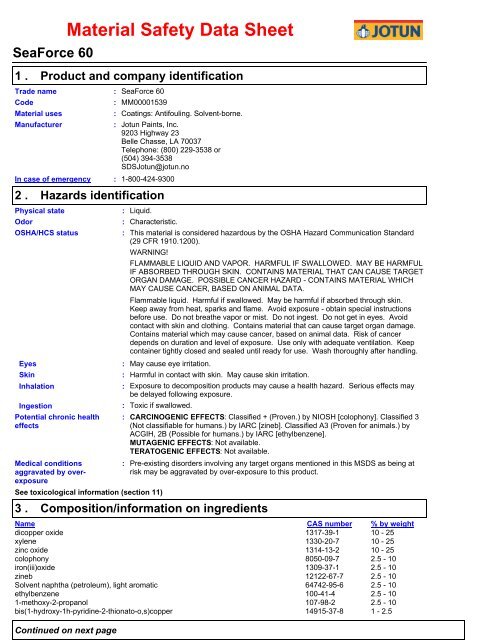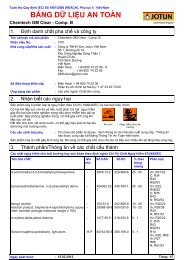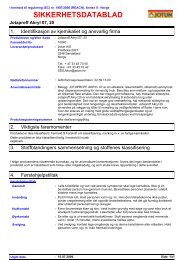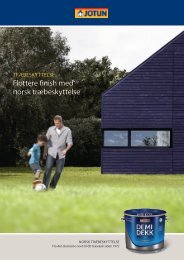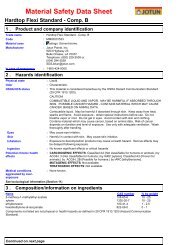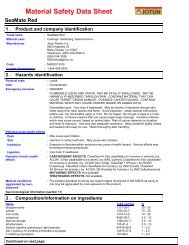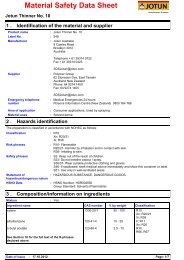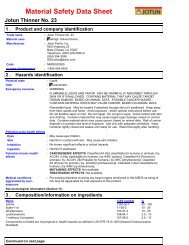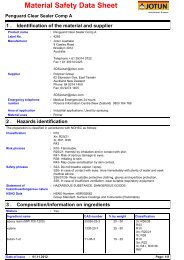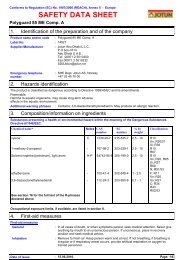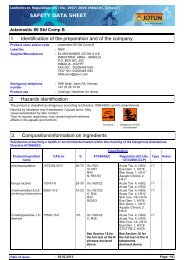SDS - SeaForce 60 - Marine_Protective - English (us) - Jotun
SDS - SeaForce 60 - Marine_Protective - English (us) - Jotun
SDS - SeaForce 60 - Marine_Protective - English (us) - Jotun
You also want an ePaper? Increase the reach of your titles
YUMPU automatically turns print PDFs into web optimized ePapers that Google loves.
<strong>SeaForce</strong> <strong>60</strong>1 .Trade nameCodeMaterial <strong>us</strong>esManufacturerIn case of emergency2 .Physical stateEyesSkinInhalationIngestionMaterial Safety Data SheetProduct and company identification: <strong>SeaForce</strong> <strong>60</strong>: MM00001539: Coatings: Antifouling. Solvent-borne.: <strong>Jotun</strong> Paints, Inc.9203 Highway 23Belle Chasse, LA 70037Telephone: (800) 229-3538 or(504) 394-3538<strong>SDS</strong><strong>Jotun</strong>@jotun.no:1-800-424-9300Hazards identificationOdorOSHA/HCS stat<strong>us</strong>Potential chronic healtheffectsMedical conditionsaggravated by overexposureSee toxicological information (section 11)3 .: Liquid.: Characteristic.: This material is considered hazardo<strong>us</strong> by the OSHA Hazard Communication Standard(29 CFR 1910.1200).WARNING!FLAMMABLE LIQUID AND VAPOR. HARMFUL IF SWALLOWED. MAY BE HARMFULIF ABSORBED THROUGH SKIN. CONTAINS MATERIAL THAT CAN CAUSE TARGETORGAN DAMAGE. POSSIBLE CANCER HAZARD - CONTAINS MATERIAL WHICHMAY CAUSE CANCER, BASED ON ANIMAL DATA.Flammable liquid. Harmful if swallowed. May be harmful if absorbed through skin.Keep away from heat, sparks and flame. Avoid exposure - obtain special instructionsbefore <strong>us</strong>e. Do not breathe vapor or mist. Do not ingest. Do not get in eyes. Avoidcontact with skin and clothing. Contains material that can ca<strong>us</strong>e target organ damage.Contains material which may ca<strong>us</strong>e cancer, based on animal data. Risk of cancerdepends on duration and level of exposure. Use only with adequate ventilation. Keepcontainer tightly closed and sealed until ready for <strong>us</strong>e. Wash thoroughly after handling.: May ca<strong>us</strong>e eye irritation.: Harmful in contact with skin. May ca<strong>us</strong>e skin irritation.: Exposure to decomposition products may ca<strong>us</strong>e a health hazard. Serio<strong>us</strong> effects maybe delayed following exposure.: Toxic if swallowed.: CARCINOGENIC EFFECTS: Classified + (Proven.) by NIOSH [colophony]. Classified 3(Not classifiable for humans.) by IARC [zineb]. Classified A3 (Proven for animals.) byACGIH, 2B (Possible for humans.) by IARC [ethylbenzene].MUTAGENIC EFFECTS: Not available.TERATOGENIC EFFECTS: Not available.:Pre-existing disorders involving any target organs mentioned in this M<strong>SDS</strong> as being atrisk may be aggravated by over-exposure to this product.Composition/information on ingredientsName CAS number % by weightdicopper oxide 1317-39-1 10 - 25xylene 1330-20-7 10 - 25zinc oxide 1314-13-2 10 - 25colophony 8050-09-7 2.5 - 10iron(iii)oxide 1309-37-1 2.5 - 10zineb 12122-67-7 2.5 - 10Solvent naphtha (petroleum), light aromatic 64742-95-6 2.5 - 10ethylbenzene 100-41-4 2.5 - 101-methoxy-2-propanol 107-98-2 2.5 - 10bis(1-hydroxy-1h-pyridine-2-thionato-o,s)copper 14915-37-8 1 - 2.5Continued on next page
<strong>SeaForce</strong> <strong>60</strong> Page: 2/103 .Composition/information on ingredientsComponents not listed are not physical or health hazards as defined in 29 CFR 1910.1200 (Hazard CommunicationStandard).Section 4. First aid measuresEye contactSkin contactInhalationIngestionProtection of first-aiders::::Check for and remove any contact lenses. Immediately fl<strong>us</strong>h eyes with plenty ofwater for at least 15 minutes, occasionally lifting the upper and lower eyelids. Getmedical attention immediately.In case of contact, immediately fl<strong>us</strong>h skin with plenty of water for at least 15 minuteswhile removing contaminated clothing and shoes. Wash clothing before re<strong>us</strong>e.Clean shoes thoroughly before re<strong>us</strong>e. Get medical attention immediately.Move exposed person to fresh air. If not breathing, if breathing is irregular or ifrespiratory arrest occurs, provide artificial respiration or oxygen by trained personnel.Loosen tight clothing such as a collar, tie, belt or waistband. Get medical attentionimmediately.Wash out mouth with water. Do not induce vomiting unless directed to do so bymedical personnel. Never give anything by mouth to an unconscio<strong>us</strong> person. Getmedical attention immediately.: No action shall be taken involving any personal risk or without suitable training. If itis s<strong>us</strong>pected that fumes are still present, the rescuer should wear an appropriatemask or self-contained breathing apparat<strong>us</strong>. It may be dangero<strong>us</strong> to the personproviding aid to give mouth-to-mouth res<strong>us</strong>citation. Wash contaminated clothingthoroughly with water before removing it, or wear gloves.5 .Fire-fighting measuresFlammability of the productProducts of comb<strong>us</strong>tionSpecial exposure hazards :Special protectiveequipment for fire-fighters::Suitable :Not suitable ::Flammable.Decomposition products may include the following materials:carbon dioxidecarbon monoxidenitrogen oxidessulfur oxidesmetal oxide/oxidesUse dry chemical, CO2, water spray (fog) or foam.Do not <strong>us</strong>e water jet.Promptly isolate the scene by removing all persons from the vicinity of the incident ifthere is a fire. No action shall be taken involving any personal risk or without suitabletraining. Move containers from fire area if this can be done without risk. Use waterspray to keep fire-exposed containers cool.Flammable liquid. In a fire or if heated, a pressure increase will occur and the containermay burst, with the risk of a subsequent explosion. Runoff to sewer may create fire orexplosion hazard.Fire-fighters should wear appropriate protective equipment and self-contained breathingapparat<strong>us</strong> (SCBA) with a full face-piece operated in positive pressure mode.Section 6. Accidental release measuresPersonal precautions : No action shall be taken involving any personal risk or without suitable training.Evacuate surrounding areas. Keep unnecessary and unprotected personnel fromentering. Do not touch or walk through spilled material. Shut off all ignition sources.No flares, smoking or flames in hazard area. Do not breathe vapor or mist. Provideadequate ventilation. Wear appropriate respirator when ventilation is inadequate.Put on appropriate personal protective equipment (see section 8).Environmental precautions : Avoid dispersal of spilled material and runoff and contact with soil, waterways, drainsand sewers. Inform the relevant authorities if the product has ca<strong>us</strong>ed environmentalpollution (sewers, waterways, soil or air).Continued on next page
<strong>SeaForce</strong> <strong>60</strong> Page: 3/10Section 6. Accidental release measuresMethods for cleaning up :Section 7. Handling and storageStop leak if without risk. Move containers from spill area. Approach release fromupwind. Prevent entry into sewers, water courses, basements or confined areas.Wash spillages into an effluent treatment plant or proceed as follows. Contain andcollect spillage with non-comb<strong>us</strong>tible, absorbent material e.g. sand, earth, vermiculiteor diatomaceo<strong>us</strong> earth and place in container for disposal according to localregulations (see section 13). Use spark-proof tools and explosion-proof equipment.Dispose of via a licensed waste disposal contractor. Contaminated absorbentmaterial may pose the same hazard as the spilled product. Note: see section 1 foremergency contact information and section 13 for waste disposal.HandlingStorage::Put on appropriate personal protective equipment (see section 8). Eating, drinkingand smoking should be prohibited in areas where this material is handled, stored andprocessed. Workers should wash hands and face before eating, drinking andsmoking. Do not get in eyes or on skin or clothing. Do not breathe vapor or mist.Do not ingest. Use only with adequate ventilation. Wear appropriate respiratorwhen ventilation is inadequate. Do not enter storage areas and confined spacesunless adequately ventilated. Keep in the original container or an approvedalternative made from a compatible material, kept tightly closed when not in <strong>us</strong>e.Store and <strong>us</strong>e away from heat, sparks, open flame or any other ignition source. Useexplosion-proof electrical (ventilating, lighting and material handling) equipment.Use non-sparking tools. Take precautionary measures against electrostaticdischarges. To avoid fire or explosion, dissipate static electricity during transfer bygrounding and bonding containers and equipment before transferring material.Empty containers retain product residue and can be hazardo<strong>us</strong>. Do not re<strong>us</strong>econtainer.Store in accordance with local regulations. Store in a segregated and approvedarea. Store in original container protected from direct sunlight in a dry, cool and wellventilatedarea, away from incompatible materials (see section 10) and food anddrink. Eliminate all ignition sources. Separate from oxidizing materials. Keepcontainer tightly closed and sealed until ready for <strong>us</strong>e. Containers that have beenopened m<strong>us</strong>t be carefully resealed and kept upright to prevent leakage. Do not storein unlabeled containers. Use appropriate containment to avoid environmentalcontamination.8 .Product nameExposure controls/personal protectionExposure limitsxylene ACGIH TLV (United States, 1/2007).STEL: 651 mg/m³ 15 minute(s).STEL: 150 ppm 15 minute(s).TWA: 434 mg/m³ 8 hour(s).TWA: 100 ppm 8 hour(s).OSHA PEL (United States, 11/2006).TWA: 435 mg/m³ 8 hour(s).TWA: 100 ppm 8 hour(s).OSHA PEL 1989 (United States, 3/1989).STEL: 655 mg/m³ 15 minute(s).STEL: 150 ppm 15 minute(s).TWA: 435 mg/m³ 8 hour(s).TWA: 100 ppm 8 hour(s).zinc oxide NIOSH REL (United States, 12/2001).CEIL: 15 mg/m³ Form: D<strong>us</strong>tTWA: 5 mg/m³ 10 hour(s). Form: D<strong>us</strong>t and fumesSTEL: 10 mg/m³ 15 minute(s). Form: FumeOSHA PEL (United States, 11/2006).TWA: 5 mg/m³ 8 hour(s). Form: FumeTWA: 5 mg/m³ 8 hour(s). Form: Respirable fractionTWA: 15 mg/m³ 8 hour(s). Form: Total d<strong>us</strong>tOSHA PEL 1989 (United States, 3/1989).STEL: 10 mg/m³ 15 minute(s). Form: FumeTWA: 5 mg/m³ 8 hour(s). Form: FumeTWA: 5 mg/m³ 8 hour(s). Form: Respirable fractionContinued on next page
<strong>SeaForce</strong> <strong>60</strong> Page: 4/108 .Exposure controls/personal protectionTWA: 10 mg/m³ 8 hour(s). Form: Total d<strong>us</strong>tACGIH TLV (United States, 1/2007).STEL: 10 mg/m³ 15 minute(s).TWA: 2 mg/m³ 8 hour(s).colophonyNIOSH REL (United States, 12/2001). Notes: Note: Carcinogenic inthe presence of formaldehyde, acetaldehyde, or malonaldehyde.See Appendix C (Aldehydes) See Appendix A - NIOSH PotentialOccupational CarcinogenTWA: 0,1 mg/m³ 10 hour(s). Form: All formsOSHA PEL 1989 (United States, 3/1989).TWA: 0,1 mg/m³ 8 hour(s). Form: All formsiron(iii)oxide OSHA PEL 1989 (United States, 3/1989).TWA: 5 mg/m³ 8 hour(s). Form: Respirable fractionTWA: 10 mg/m³ 8 hour(s). Form: Total d<strong>us</strong>tACGIH TLV (United States, 1/2007).TWA: 5 mg/m³ 8 hour(s). Form: Respirable fractionOSHA PEL (United States, 11/2006).TWA: 10 mg/m³ 8 hour(s).OSHA PEL 1989 (United States, 3/1989). Notes: as FeSTEL: 10 ppm, (as Fe) 15 minute(s). Form: Total particulatesNIOSH REL (United States, 12/2001). Notes: as FeTWA: 5 mg/m³, (as Fe) 10 hour(s). Form: D<strong>us</strong>t and fumesSolvent naphtha (petroleum), light aromatic NIOSH REL (United States, 6/2001).TWA: 125 mg/m³ 10 hour(s). Form: All formsTWA: 25 ppm 10 hour(s). Form: All formsACGIH TLV (United States, 1/2005).TWA: 123 mg/m³ 8 hour(s). Form: All formsTWA: 25 ppm 8 hour(s). Form: All formsOSHA PEL 1989 (United States, 3/1989).TWA: 125 mg/m³ 8 hour(s). Form: All formsTWA: 25 ppm 8 hour(s). Form: All formsethylbenzeneACGIH TLV (United States, 1/2005). Notes: 2002 Adoption.Substances for which there is a Biological Exposure Index orIndicesSTEL: 125 ppm 15 minute(s). Form: All formsTWA: 100 ppm 8 hour(s). Form: All formsNIOSH REL (United States, 12/2001).STEL: 545 mg/m³ 15 minute(s). Form: All formsSTEL: 125 ppm 15 minute(s). Form: All formsTWA: 435 mg/m³ 10 hour(s). Form: All formsTWA: 100 ppm 10 hour(s). Form: All formsOSHA PEL (United States, 8/1997).TWA: 435 mg/m³ 8 hour(s). Form: All formsTWA: 100 ppm 8 hour(s). Form: All formsOSHA PEL 1989 (United States, 3/1989).STEL: 545 mg/m³ 15 minute(s). Form: All formsSTEL: 125 ppm 15 minute(s). Form: All formsTWA: 435 mg/m³ 8 hour(s). Form: All formsTWA: 100 ppm 8 hour(s). Form: All forms1-methoxy-2-propanol ACGIH TLV (United States, 1/2008).STEL: 553 mg/m³ 15 minute(s).STEL: 150 ppm 15 minute(s).TWA: 369 mg/m³ 8 hour(s).TWA: 100 ppm 8 hour(s).NIOSH REL (United States, 6/2008).STEL: 540 mg/m³ 15 minute(s).STEL: 150 ppm 15 minute(s).TWA: 3<strong>60</strong> mg/m³ 10 hour(s).TWA: 100 ppm 10 hour(s).OSHA PEL 1989 (United States, 3/1989).STEL: 540 mg/m³ 15 minute(s).STEL: 150 ppm 15 minute(s).Continued on next page
<strong>SeaForce</strong> <strong>60</strong> Page: 5/108 .Exposure controls/personal protectionTWA: 3<strong>60</strong> mg/m³ 8 hour(s).TWA: 100 ppm 8 hour(s).Engineering measuresEyesSkinRespiratoryHands :Hygiene measures: Use only with adequate ventilation. Use process enclosures, local exha<strong>us</strong>t ventilation orother engineering controls to keep worker exposure to airborne contaminants below anyrecommended or statutory limits. The engineering controls also need to keep gas, vaporor d<strong>us</strong>t concentrations below any lower explosive limits. Use explosion-proof ventilationequipment.:::Safety eyewear complying with an approved standard should be <strong>us</strong>ed when a riskassessment indicates this is necessary to avoid exposure to liquid splashes, mists ord<strong>us</strong>ts.Personal protective equipment for the body should be selected based on the task beingperformed and the risks involved and should be approved by a specialist before handlingthis product.Use a properly fitted, air-purifying or air-fed respirator complying with an approvedstandard if a risk assessment indicates this is necessary. Respirator selection m<strong>us</strong>t bebased on known or anticipated exposure levels, the hazards of the product and the safeworking limits of the selected respirator.Chemical-resistant, impervio<strong>us</strong> gloves complying with an approved standard should beworn at all times when handling chemical products if a risk assessment indicates this isnecessary.: Wash hands, forearms and face thoroughly after handling chemical products, beforeeating, smoking and <strong>us</strong>ing the lavatory and at the end of the working period. Appropriatetechniques should be <strong>us</strong>ed to remove potentially contaminated clothing. Washcontaminated clothing before re<strong>us</strong>ing. Ensure that eyewash stations and safety showersare close to the workstation location.9 .Physical and chemical propertiesPhysical stateFlash pointColorOdorRelative densityVOC: Liquid.: Closed cup: 28°C (82,4°F): Vario<strong>us</strong> colors.: Characteristic.: 1.7 g/cm 3: 3.5 pounds/gallon (US)14.19 pounds/gallon420 (g/l).Solubility:Insoluble in the following materials: cold water and hot water.Section 10. Stability and reactivityStability and reactivityHazardo<strong>us</strong> decompositionproductsHazardo<strong>us</strong> polymerization:::The product is stable.Under normal conditions of storage and <strong>us</strong>e, hazardo<strong>us</strong> decomposition productsshould not be produced.Under normal conditions of storage and <strong>us</strong>e, hazardo<strong>us</strong> polymerization will notoccur.Continued on next page
<strong>SeaForce</strong> <strong>60</strong> Page: 6/10Section 11. Toxicological informationChronic effects on humansOther toxic effects onhumansSpecific effectsCarcinogenic effectsMutagenic effectsReproduction toxicityChronic effectsTarget organs12 .Ecological informationProducts of degradation:::::::CARCINOGENIC EFFECTS: Classified + (Proven.) by NIOSH [colophony].Classified 3 (Not classifiable for humans.) by IARC [zineb]. Classified A3 (Proven foranimals.) by ACGIH, 2B (Possible for humans.) by IARC [ethylbenzene].Contains material which ca<strong>us</strong>es damage to the following organs: lungs, upperrespiratory tract, skin, central nervo<strong>us</strong> system (CNS), eye, lens or cornea.Contains material which may ca<strong>us</strong>e damage to the following organs: blood, kidneys,liver, gastrointestinal tract.Hazardo<strong>us</strong> by the following route of exposure: of skin contact (sensitizer).Contains material which may ca<strong>us</strong>e cancer, based on animal data. Risk of cancerdepends on duration and level of exposure.No known significant effects or critical hazards.No known significant effects or critical hazards.Contains material that can ca<strong>us</strong>e target organ damage.Contains material which ca<strong>us</strong>es damage to the following organs: lungs, upperrespiratory tract, skin, central nervo<strong>us</strong> system (CNS), eye, lens or cornea.Contains material which may ca<strong>us</strong>e damage to the following organs: blood, kidneys,liver, gastrointestinal tract.Ecotoxicity dataProduct/ingredient nameSpecies Period Resultdicopper oxide Daphnia (EC50) 48 hour(s) 0.51 mg/lxyleneOncorhynch<strong>us</strong> mykiss (LC50)Oncorhynch<strong>us</strong> mykiss (LC50)Lepomis macrochir<strong>us</strong> (LC50)Lepomis macrochir<strong>us</strong> (LC50)Lepomis macrochir<strong>us</strong> (LC50)Pimephales promelas (LC50)96 hour(s)96 hour(s)96 hour(s)96 hour(s)96 hour(s)96 hour(s)3.3 mg/l8.2 mg/l8.6 mg/l12 mg/l13.3 mg/l13.4 mg/lzinc oxidezinebSolvent naphtha (petroleum), lightaromaticethylbenzenebis(1-hydroxy-1h-pyridine-2-thionatoo,s)copperEnvironmental precautionsDaphnia magna (EC50)Oncorhynch<strong>us</strong> mykiss (LC50)Lepomis macrochir<strong>us</strong> (LC50)Pimephales promelas (LC50)Poecilia reticulata (LC50)Lepomis macrochir<strong>us</strong> (LC50)Lepomis macrochir<strong>us</strong> (LC50)Trout (LC50)Fish (LC50)Daphnia (EC50)Algae (IC50)Daphnia magna (EC50)Daphnia magna (EC50)Selenastrum capricornutum(EC50)Oncorhynch<strong>us</strong> mykiss (LC50)Pimephales promelas (LC50)Poecilia reticulata (LC50)Fish (LC50)Daphnia (EC50)Algae (IC50)48 hour(s)96 hour(s)96 hour(s)96 hour(s)96 hour(s)96 hour(s)96 hour(s)96 hour(s)96 hour(s)48 hour(s)72 hour(s)48 hour(s)48 hour(s)48 hour(s)96 hour(s)96 hour(s)96 hour(s)96 hour(s)48 hour(s)120 hour(s)>1000 mg/l1.1 mg/l>320 mg/l2246 mg/l7.2 mg/l>180 mg/l180 mg/l0.225 mg/l
<strong>SeaForce</strong> <strong>60</strong> Page: 7/1013 .Disposal considerationsWaste disposal:The generation of waste should be avoided or minimized wherever possible. Emptycontainers or liners may retain some product residues. This material and its containerm<strong>us</strong>t be disposed of in a safe way. Dispose of surpl<strong>us</strong> and non-recyclable products viaa licensed waste disposal contractor. Disposal of this product, solutions and any byproductsshould at all times comply with the requirements of environmental protectionand waste disposal legislation and any regional local authority requirements. Avoiddispersal of spilled material and runoff and contact with soil, waterways, drains andsewers.Disposal should be in accordance with applicable regional, national and local laws and regulations. Localregulations may be more stringent than regional or national requirements.The information presented below only applies to the material as supplied. The identification based oncharacteristic(s) or listing may not apply if the material has been <strong>us</strong>ed or otherwise contaminated. It is theresponsibility of the waste generator to determine the toxicity and physical properties of the material generated todetermine the proper waste identification and disposal methods in compliance with applicable regulations.Refer to Section 7: HANDLING AND STORAGE and Section 8: EXPOSURE CONTROLS/PERSONAL PROTECTIONfor additional handling information and protection of employees.Section 14. Transport informationRegulatoryinformationUN numberProper shippingnameClass PG* Label AdditionalinformationDOT Classification3009Copper basedpesticide, liquid,toxic, flammable(bis(1-hydroxy-1hpyridine-2-thionatoo,s)copper,xylene)6.1 III-POISON6FLAMMABLE LIQUID3TDG Classification 3009 Copper based 6.1pesticide, liquid,toxic, flammable(bis(1-hydroxy-1hpyridine-2-thionatoo,s)copper,xylene)III6-3ADR/RID Class3009Copper basedpesticide, liquid,toxic, flammable(bis(1-hydroxy-1hpyridine-2-thionatoo,s)copper,xylene)6.1 III6Tunnel restrictioncode: (D/E)Hazard identificationnumber: 633IMDG Class3009Copper basedpesticide, liquid,toxic, flammable(bis(1-hydroxy-1hpyridine-2-thionatoo,s)copper,xylene).<strong>Marine</strong> pollutant(dicopper oxide, zincoxide)6.1 III63Emergency schedules(EmS): F-E, S-D<strong>Marine</strong> pollutant: Yes.MARINE POLLUTANTContinued on next page
<strong>SeaForce</strong> <strong>60</strong> Page: 8/10Section 14. Transport informationIATA-DGR Class3009Copper basedpesticide, liquid,toxic, flammable(bis(1-hydroxy-1hpyridine-2-thionatoo,s)copper,xylene)6.1 III -63PG* : Packing group-15 .Regulatory informationHCS ClassificationU.S. Federal regulationsSARA 313Form R - ReportingrequirementsSupplier notificationState regulations:::Flammable liquidToxic materialCarcinogenTarget organ effectsUnited States inventory (TSCA 8b): Not determined.SARA 302/304/311/312 extremely hazardo<strong>us</strong> substances: No products were found.SARA 302/304 emergency planning and notification: No products were found.SARA 302/304/311/312 hazardo<strong>us</strong> chemicals: 1-methoxy-2-propanol; xylene;ethylbenzene; colophony; zineb; iron(iii)oxide; dicopper oxide; zinc oxideSARA 311/312 M<strong>SDS</strong> distribution - chemical inventory - hazard identification: 1-methoxy-2-propanol: Fire hazard, Immediate (acute) health hazard, Delayed (chronic)health hazard; xylene: Fire hazard, Immediate (acute) health hazard, Delayed (chronic)health hazard; ethylbenzene: Fire hazard, Immediate (acute) health hazard, Delayed(chronic) health hazard; colophony: Immediate (acute) health hazard, Delayed (chronic)health hazard; zineb: Delayed (chronic) health hazard; iron(iii)oxide: Delayed (chronic)health hazard; dicopper oxide: Immediate (acute) health hazard, Delayed (chronic)health hazard; zinc oxide: Immediate (acute) health hazard, Delayed (chronic) healthhazardClean Water Act (CWA) 307: ethylbenzene; copper oxide; dicopper oxide; cadmium;zinc oxideClean Water Act (CWA) 311: xylene; ethylbenzeneClean Air Act (CAA) 112 accidental release prevention: No products were found.Clean Air Act (CAA) 112 regulated flammable substances: No products were found.Clean Air Act (CAA) 112 regulated toxic substances: No products were found.Product name CAS number Concentration: dicopper oxide 1317-39-1 10 - 25xylene 1330-20-7 10 - 25zinc oxide 1314-13-2 10 - 25zineb 12122-67-7 2.5 - 10ethylbenzene 100-41-4 2.5 - 10: dicopper oxide 1317-39-1 10 - 25xylene 1330-20-7 10 - 25zinc oxide 1314-13-2 10 - 25zineb 12122-67-7 2.5 - 10ethylbenzene 100-41-4 2.5 - 10SARA 313 notifications m<strong>us</strong>t not be detached from the M<strong>SDS</strong> and any copying and redistribution of the M<strong>SDS</strong> shallinclude copying and redistribution of the notice attached to copies of the M<strong>SDS</strong> subsequently redistributed.Continued on next pageConnecticut Carcinogen Reporting: None of the components are listed.Connecticut Hazardo<strong>us</strong> Material Survey: None of the components are listed.Florida substances: None of the components are listed.Illinois Chemical Safety Act: None of the components are listed.Illinois Toxic Substances Disclosure to Employee Act: None of the components arelisted.Louisiana Reporting: None of the components are listed.Louisiana Spill: None of the components are listed.Massach<strong>us</strong>etts Spill: None of the components are listed.Massach<strong>us</strong>etts Substances: The following components are listed: ZINC OXIDE FUME;
<strong>SeaForce</strong> <strong>60</strong> Page: 10/1016 .Other informationNational Fire ProtectionAssociation (U.S.A.):Health330FlammabilityInstabilitySpecialReferencesOther specialconsiderations::This product does not contain organotin compounds acting as biocides and complies withthe International Convention on the Control of Harmful Anti-fouling Systems on Ships asadopted by IMO in October 2001 (IMO document AFS/CONF/26).IMO Antifouling System Convention compliant (AFS/CONF/26)Date of issue:03.12.2009.VersionNotice to reader:1To the best of our knowledge, the information contained herein is accurate. However, neither the above-namedsupplier, nor any of its subsidiaries, assumes any liability whatsoever for the accuracy or completeness of theinformation contained herein.Final determination of suitability of any material is the sole responsibility of the <strong>us</strong>er. All materials may presentunknown hazards and should be <strong>us</strong>ed with caution. Although certain hazards are described herein, we cannotguarantee that these are the only hazards that exist.Indicates information that has changed from previo<strong>us</strong>ly issued version.


